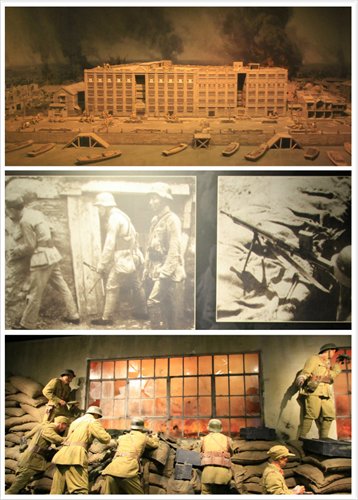War of the warehouse
Renovated memorial site commemorates heroic defense
On August 13, 1937, Japanese forces launched a massive attack on Shanghai, prompting the beginning of the Battle of Shanghai, also known as the Songhu Battle, which lasted until November 12 that year. A total of 1 million troops were involved in brutal fighting, with the battle described by the AFP journalist Peter Harmsen as "Stalingrad on the Yangtze." (From top) A model of the original Sihang Warehouse, a photo and a sculpture of defending soldiers on display at the newly opened Sihang Warehouse Defense Memorial Photos: Qi Xijia/GT
This year, 78 years to the day that the Songhu Battle started, Sihang Warehouse Defense Memorial in Shanghai Zhabei district was reopened to the public after restoration work that lasted almost 12 months.
Located across Suzhou Creek from the foreign concessions, Sihang Warehouse was the site of a morale-boosting defense by the Chinese covering the withdrawal of their forces from October 26 to November 1, 1937.
Sihang Warehouse was built jointly by four banks in 1931 ("Sihang" means "four banks" in Chinese). At the time of the battle, the six-story concrete building was being used as the divisional headquarters of the Chinese army's 88th Division.
In October 1937, as the Chinese resistance in Zhabei district was faltering, a single reinforced-strength battalion of over 420 soldiers was ordered to remain behind to defend against the Japanese army as Chinese forces withdrew from Shanghai.

'Eight Hundred Warriors'
Xie Jinyuan, executive officer of the 524th Regiment, 262nd Brigade, 88th Division of the Chinese army was entrusted with the mission to lead this battalion, known as the "Eight Hundred Warriors" - an exaggeration aimed at deceiving the Japanese.
In the battle that lasted four days and four nights, the defenders held against more than 10 offensives by the Japanese army, killing or wounding more than 200 Japanese soldiers, while losing just 10 of their own.
The Sihang Warehouse Defense Memorial commemorates the fighting deeds and heroism of the defenders through photos, sculptures, multimedia devices and objects from the battle, many of which are presented for the first time.
Numerous sculptures reflect the courage of the Eight Hundred Warriors in the face of a seemingly hopeless situation. One sculpture shows the soldiers staving off hunger with boiled soya beans after a day's intense fighting.
Another sculpture features a 21-year-old solider jumping from the warehouse with a grenade in his hand, sacrificing his own life to take down some 20 Japanese soldiers.
There is also a remembrance wall for the defenders, which is the most comprehensive list of the Chinese troops involved to date. This includes 323 names from records from Tongcheng county, Xianning city of Hubei Province, from where many of the soldiers came.
Pitching in
Citizens living along Suzhou Creek also played a part in the defense and aided the Chinese soldiers. One video installation shows citizens pack on the southern bank of the creek, holding billboards telling the Chinese soldiers the number of Japanese invaders and the direction they were approaching from.
The battle was covered by foreign media. Among these reports was a series of photos taken by the Associated Press journalist Hyland Lyon. They show Sihang Warehouse in flames and the retreat of the defenders to the foreign concessions, playing a vital role in preserving the images of the time, including the faces of the defenders themselves.
"The defense took place in the full view of the international community and local people. Foreign media reported the defense of the Sihang Warehouse, which fully explained the influence of this battle. At the same time, this boosted confidence of winning the anti-Japanese war," said Zhang Zhong, deputy director of the Bureau of Cultural Affairs of Zhabei district. "With this memorial, we hope to commemorate the national heroes who sacrificed their lives, and let more citizens, especially young people, know this history."
Past meets future
Restoring Sihang Warehouse to its original state was not an easy task, as the building has undergone repeated renovation over its lifetime.
The restoration involved using original blueprints, documents and video. The western wall, now the frontage of the Sihang Warehouse Defense Memorial, preserves the marks of eight shells and more than 430 bullets left during the battle and uncovered by experts.
To locate the holes Tang Yu'en, chief architect of the restoration project, and her team consulted many materials, including engineering and structural drawings, and photos of the damage before it was covered up.
"When the warehouse was constructed, it was built with high-quality black bricks. After the war, the holes were filled in with red bricks. By removing the coating, we can see the border of different bricks and locate the holes," Tang told the Global Times.
As well as serving as a memorial, Tang says there are plans to use the east side of the warehouse as a creative park. "The building complex reflects the idea of memorizing the past and facing the future," said Tang.